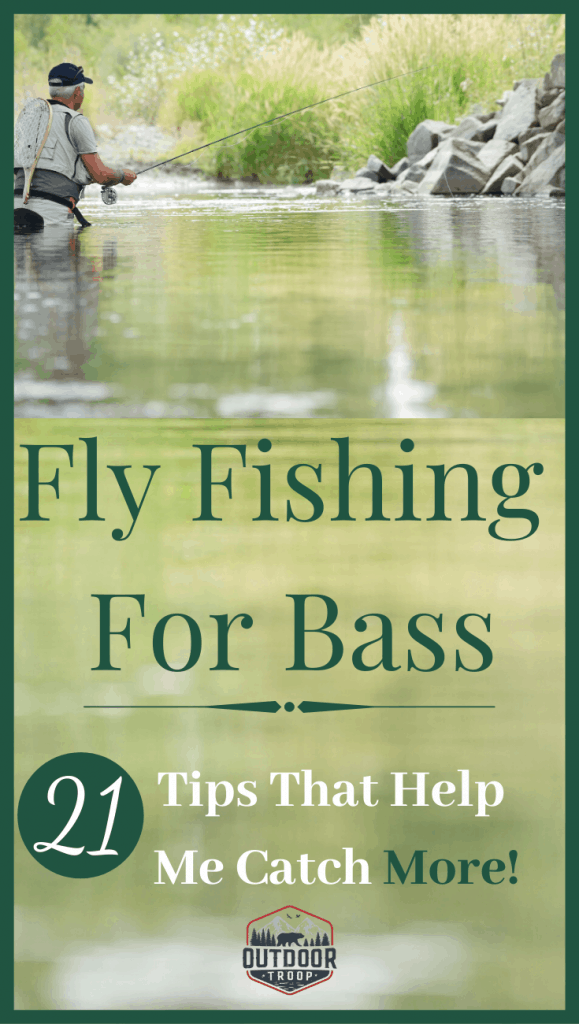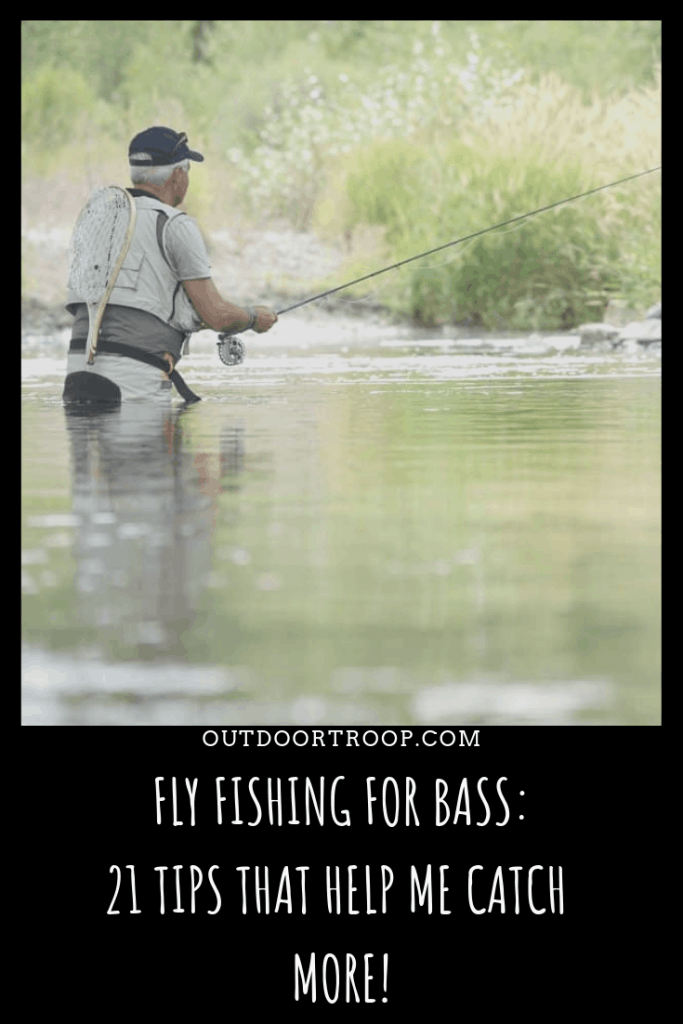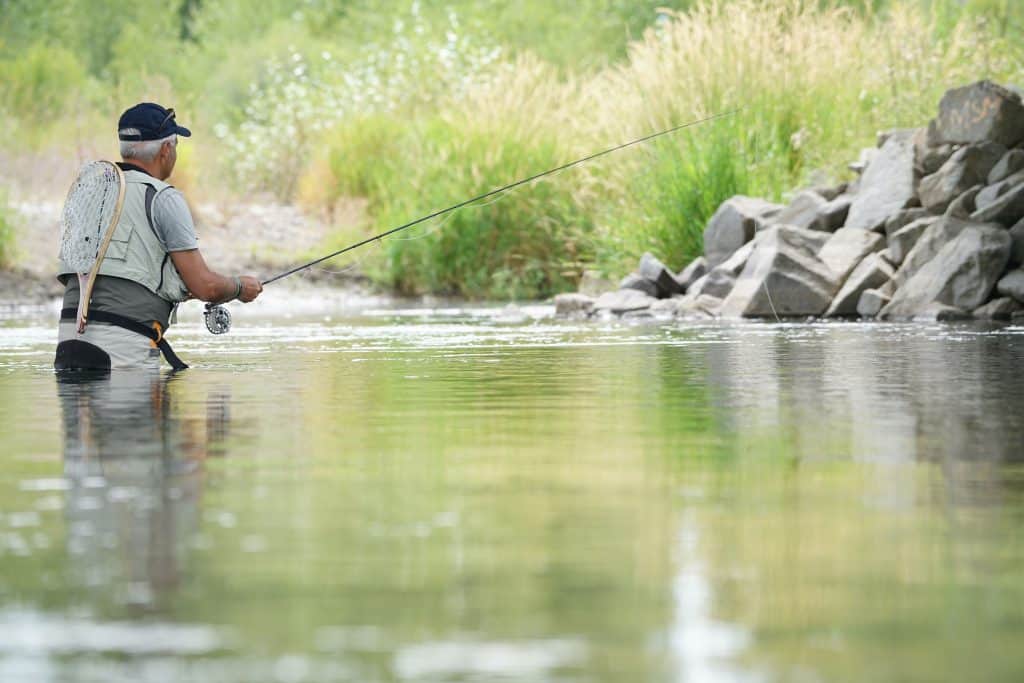
I’ve been trying to improve my skill at fly fishing for bass for a while now. At this point, I have collected some great tips for anyone in the same situation.
When it comes to fly fishing for bass, there are a number of important factors which will affect your success. These factors can range anywhere from picking the right time of day to fish to using the proper fishing rod. I’ve found some answers to bass fly fishing questions and summarized them here for you in 21 helpful tips!
#1: Get Up Early, Stay Out Late
One of the first things you need to do if you want to catch bass is to target them at the proper time of day. A lot of factors might influence what the “best” time of day for bass fishing is, but the season is actually a big one.
Bass linger closer to shore during the early hours of the morning and tend to return during the late evening.
Consider getting out on the water by 4 am in the summertime.
If you plan on coming home with a solid catch, you should consider getting out on the water by 4 am in the summertime. Bass are often hanging out in the shallower water during this time. If you wait for the sun to rise fully, you will have better luck in water that is at least 20 ft away from the bank.
If you would prefer to fish from the shoreline and avoid getting in the water, then the best time for you to fish for bass is during the first morning light or at the very last light of day.
Getting up this early or staying out this late may sound like an exhausting thing to do, but experience has shown that these are the best times to catch bass. They’re more likely to be feeding in periods of lower light.
As an added bonus, if you get up early, you’ll have less competition from other fishermen!
#2: Fish During Periods of Low Light
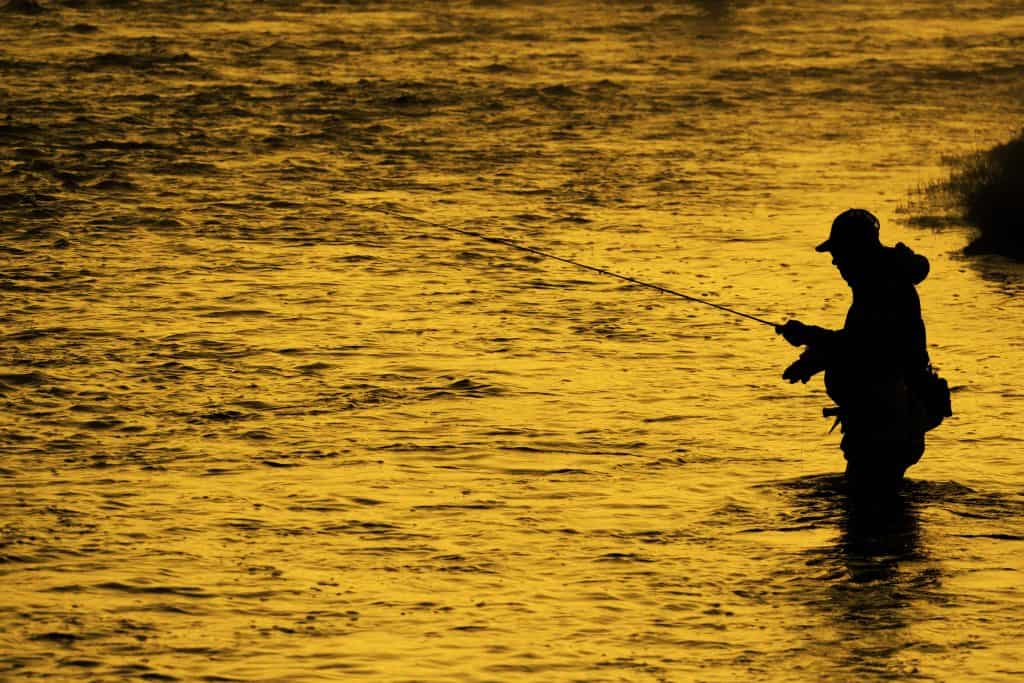
If you don’t want to go early in the morning, that’s just fine. It may limit your options as far as fishing days go, but all hope is not lost. When you do decide to get out there with
There are a variety of things that could cause this. Cloudy skies, rain, or heavy smoke/dust can all affect the lighting conditions.
During periods of low lighting, largemouth bass are more likely to be feeding along the surface of the water, as they often mistake it for dawn or dusk. You should use this quirk to your advantage when you’re out on the river. If you go on days that are dim or cloudy, you’re more likely to hook a bass that’s feeding in shallow waters.
#3: Get the Right Fly Fishing Rod
A good fly fishing rod for bass can be expensive, but it’s a seriously worthwhile investment.
There are four models I would recommended:
- Echo EPR Fly Rod: This costs $449.99. It is incredibly lightweight, super fast and super powerful, it has fabric covered tube, stainless Guides with SIC stripper, two grip styles, and the reel seat is maintenance free aluminum with a lifetime warranty.
- Sage BASS II Fly Rod: It costs $600. It is a fast action, graphite LLLe construction, made within tournament specifications, Fuji ceramic stripping guides, hard chromed snake guides, safe for saltwater use, red anodized aluminum reel seat, pre-shook custom cork handle 6 and 1/2″ full wells grip, olive ballistic cloth rod/reel case and sage bass II line all included.
- G. Loomis NRX Fly Rod: It costs $730. It is considered to have extremely hi8gh performance, and to be very versatile in its uses, whether it be in freshwater or saltwater. It is 9’0″, 4 pieces, range in the weight of 3 to 12 size, considered to push the boundaries, made with lighter and higher density carbon materials making it durable, sensitive and responsive to your cast.
- Scott Meridian Fly Rod: It costs $865. It is an award-winning rod for saltwater fishing. Designed with Scott ReAct technology, made for creating powerful, tough and extremely responsive fly fishing rod options. It has an awesome recovery speed as well. It has extra knurling to ensure strong grip even when your hands are wet, a hard coating the is flat black 3 mil-spec hard coating and a lifetime warranty.
#4: Master Your Fly Fishing Rod
Whether you pay someone to teach you, or you practice over and over again for several months just to get the hang of it, you need to feel confident that you have mastered your fly fishing rod.
No Haul = No Hope
You need to be able to feel in charge of catching the bass of your dreams in order to actually do it. This will happen after you have truly mastered your own personal technique of casting.
There is a saying that “no haul equals no hope.” You need to be able to throw it out there in order to “get it back”.
When you are fly fishing for bass, your mind should be on how you are catching a fish, not on how you’re casting out your line. For this focus, you need to be confident in your casting skills, so much so that you don’t need to give it any attention.
#5: Get the Right Gear
Some of the lists below may depend on the time of year and weather which you are planning to fly fish in, but generally, here are the things you’ll want.
Overview List
- Rod and Reel
- Flashlight/Headlamp
- Extra Batteries
- Hat and Sunglasses
- Sunscreen
- Waders and Wading Boots
- Hip or Chest Pack
- Bug Spray
- Binoculars
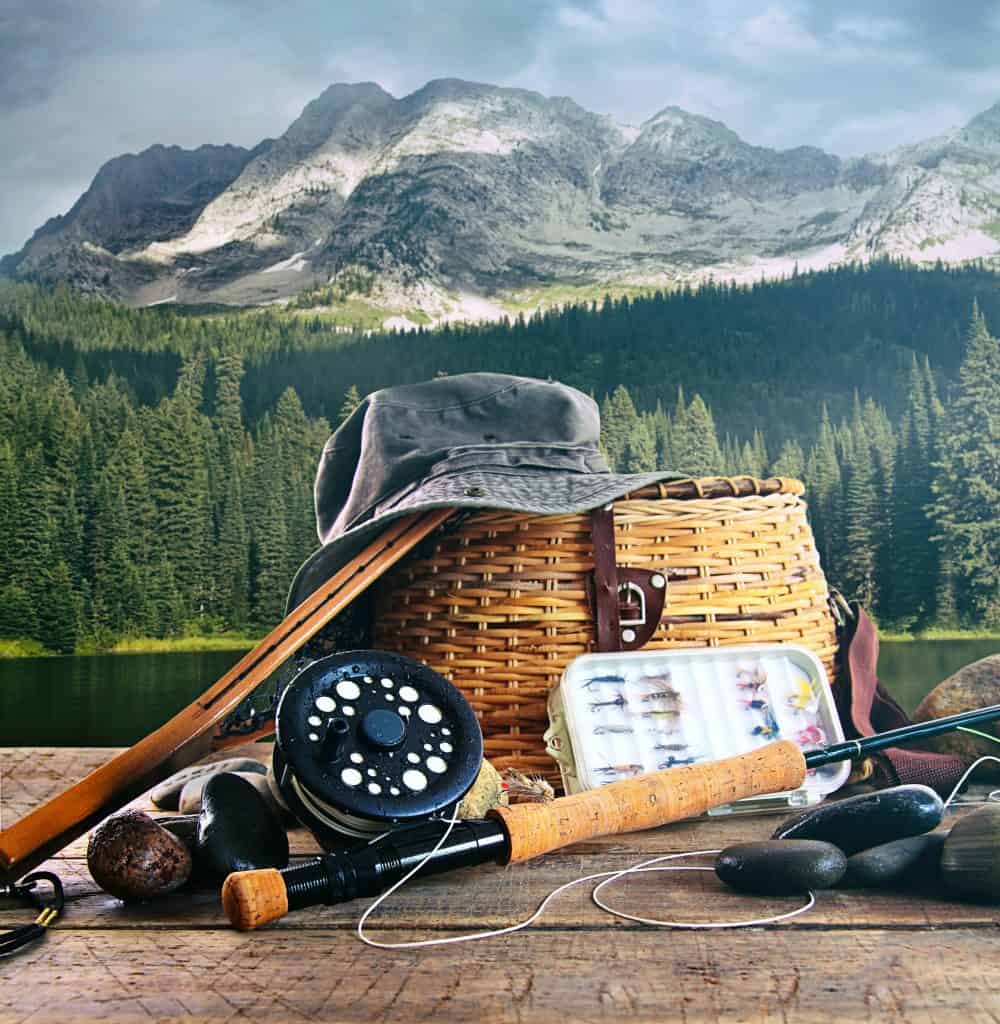
Miscellaneous Gear
- Fly Floatant
- Nippers
- Fishing Vest
- Wading Staff
- Net
- Hip or Chest Pack to Hold Gear
Rods and Reels
- Sinking Tip Line
- 5 to 6-Weight Rod (for larger rivers or bodies of water)
- 3 to 4-Weight Rod (for small rivers or bodies of water)
- 9′ Rod with 5 to 6-Weight Floating Line
- Matching Reels and Lines
Waders and Wading Boots
- Light and Breathable Waders
- Layers for Warmth (long underwear for the top and bottom fleece underwear)
- Wading Boots (preferably felt-soled)
Leaders and Tippets
- A Versatile Leader (9′ and 4 pieces, usually)
- Tippet Material Spools (3x, 4x, 5x, 6x)
#6: Be One with the Tide
Everyone knows that the moon controls the tides. If you understand the natural patterns and rhythms of the moon’s cycle, you will be better prepared to decide when it is the best time to head out and fly fish for your bass.
There are small tides and strong tides. These can be tracked on a tidal graph. It will appear in the form of two humps. For your best shot at a good catch, try to go when the graph shows growth from the small hump to a large one.
#7: Consider Using A Fishing Guide
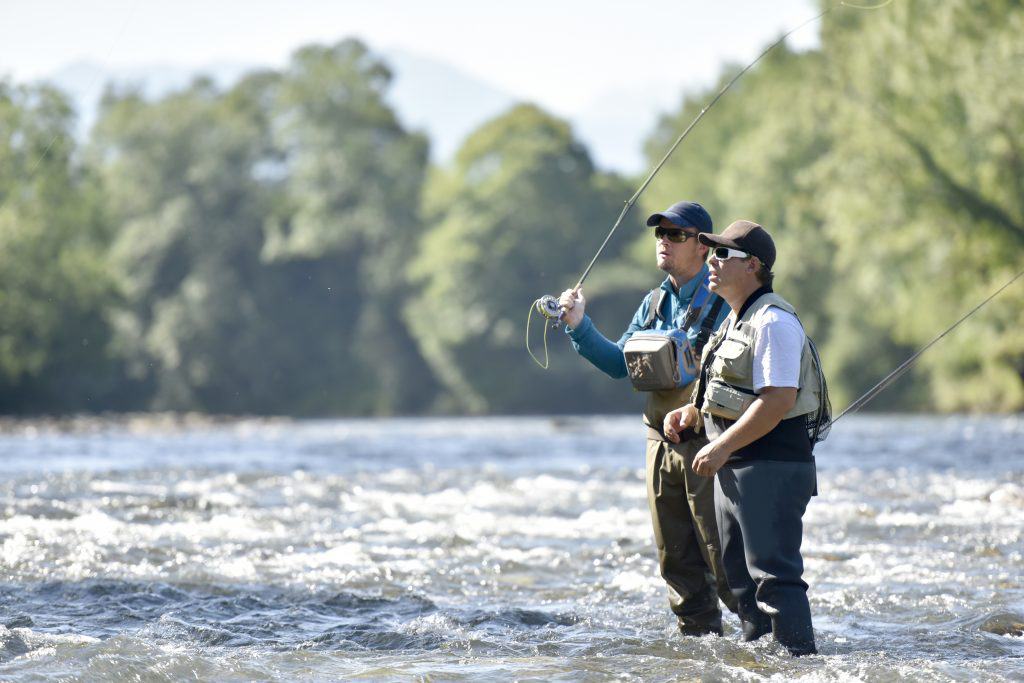
If you are new to fly fishing for bass, consider taking a trip or two out on the water with a professional. That may sound intimidating, but having someone with skill and experience coaching you can help immensely.
Maybe you have been fishing for years. Well, a professional can simply teach you new tricks and help you refresh what you already know. Or, you may consider becoming a professional fishing guide.
#8: Think Outside The Box When it Comes to Lures
A little-known fact is that frog, rat, and duckling lures are highly effective. Because of the rarity of these lures, you often catch
The really cool thing about using frog, rat, and duckling as lures is that while they will help you catch fish during low lighting (the prime time), they also help with fishing in the dark. Bass are drawn to these lures and will come out at any time of day or night to try and snag them.
You’ll have better luck fishing at any time of the day if you use a heavy (10 to 12 weight) fly rod and if you’re using a good-sized topwater fly.
#9: Maintain Some Line Tension
You will need to keep constant tension on the subsurface of your bass fly. Bass are often very subtle when taking the bait, and you may not notice it at first, even from your larger catches. However, with more tension, you are more likely to feel any slight pulls or light tugs.
The purpose of fly fishing is to keep a realistic semblance of bugs or insects resting on the water, so the idea of keeping tension on the line might seem a little difficult. However, with the natural currents, tides, pushes, or pulls of the water you’re fishing in, you’ll find that enough movement is provided which will enable you to occasionally check and make sure your fly fishing line is taut. If it isn’t, take back just a bit of the slack.
If you find that you’ve pulled back a lot of the slack and your line is dangerously far from the area of water you intended to fish, you may want to reel it back in and cast your fly back out.
#10: Practice Makes Permanent
Practicing for a whole season may not sound like your bass-catching dream, but believe me, it really pays off in the long run. Down the line (pun intended), you will be grateful you got to practice as much as you did, whether you were reeling in catches or not during that time period.
Sometimes, we need to simply take action, springing into practice without knowing everything first.
Find a nice spot around the shore of the body of water you’ve chosen and fish strictly within that stretch for a whole season. Learn the movement of the water, see how your line and fly react with the wind, discover which parts of that section where bass are most likely to lie, pay attention to the placements and patterns that continually appear, and take time to breathe in nature, away from fishing tips and guides.
This could possibly feel like it’s dragging on, but if you focus on coming to understand the territory and the patterns of bass in your area, your shot of being more successful rises each passing year.
#11: Reel the Bass in Quickly
Fly fishing for bass is a little different than fishing for any other type of freshwater fish. Try to get in the mindset of saltwater fly fishing (even though you’re not).
When it comes to larger bass, you will want to avoid lifting your rod after you set the hook. This will send your prize away quickly.
When the bass finally bites, reel the line back aggressively and put pressure on the side of the rod. Try to keep your rod pointed directly towards the fly during the retrieval process. You can even try burying the tip a few inches under the water for good measure.
#12: Stop for a Beat
In rare but exhilarating situations, bass may inhale your fly right off the surface of the water. You more than likely will not be prepared for this, as it happens when you are relaxed and least expect it. Bass are sly fish and are able to almost “pounce” on their prey quietly and in the blink of an eye.
Try this: when your fly is first resting on water’s surface, take a few moments to let the bass see the fly. They’ll come to you. Take a break from paying constant attention to your line, but be purposeful with your break. This will give you better focus. Soon, you’ll have the opportunity to get that sneaky bass out of the water and into your hands
#13: Keep Your Fly Basic
It can be hard to catch bass while fly fishing. Why, though? The flies used in fly fishing for other types of fish are often made with leather claws, rubber legs, dumbbell eyes… some “flies” barely look like flies by the time the manufacturers are done with them. Bass aren’t necessarily drawn to that.
Remember that fish bite because they’re hungry. Not because they think it’s pretty.
If you look in your tackle box and nearly have to squint at the cacophony of colors, you might want to look for more natural-looking flies before you go bass fishing. While fish can be attracted to the bright, neon-colored lure, bait, and fly options out there, just remember that fish bite because they’re hungry. Not because they think it’s pretty.
Sometimes, if you really need some extra help, you can add some weedless Senko to your bait, or try a fly that looks like something other than an insect, but still natural. If you’re looking for some good options, I’d recommend taking a look here.
#14: Watch Your Fly’s Size
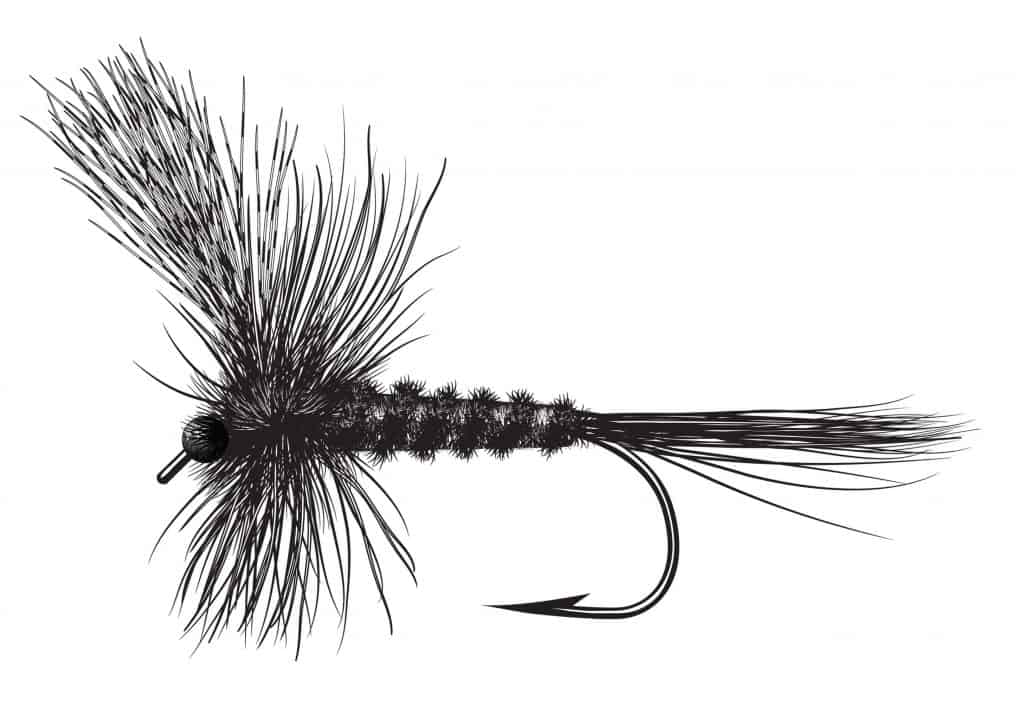
There are all sorts of options when it comes to what fly you are going to choose to use. Some have found that the “big fly, big fish” phrase is not always true. Many have found success in opting for smaller patterns.
Using a large and flashy fly may seem fun and exciting. Sometimes it even makes sense. However, when the water is dead calm on the surface, that can spook away any possible catch.
When the water is dead calm on the surface, brightly-colored flies can spook away a possible catch.
When using a smaller slider you will find that it just slips and slides right under the water without drawing unwanted, just necessary, attention to itself.
You can try using a Sneaky Pete, small Dahlberg style diver, or maybe even a Gaines bass duster.
#15: Go Big or Go Home
If you are fishing in a large body of water, then a big loud popper will give you the best performance, for sure. This can be used when the water is all choppy or maybe when you are on the outside edge of some large weed beds.
But why a loud popper? Won’t that scare bass away?
Not necessarily. While you want to be as silent as possible and not draw attention to yourself, drawing some attention to your fly or popper is perfectly reasonable. After all, that’s what you’re doing when you jig the line and try to get a bass to notice it.
Out in nature, many small bugs, insects, frogs, and so on will make a little bit of noise when they go in or out of the water, and that can be what alerts the bass to their present, resulting in a bite.
So, when you’re fishing in a big area and you’re wanting to attract the fish to you, you should be quiet, but your popper can be a little more noticeable. Just don’t make it too loud, or they’ll know something’s up. Natural prey isn’t that graceless.
#16: Don’t Seek Too Much Attention
Contrary to popular belief, you do not have to place the fly fishing line atop the water and chug it up and down two or three times to get the attention of a fish. Instead, try letting it simply sit without doing anything dramatic.
If the water is clear enough, you will eventually see a fish
This tactic is great in stiller water. If you’re fishing in a windy atmosphere or where the water naturally moves quite a bit, a still fly will have a harder time attracting the prize bass. In general, you want to make your fly seem as realistic and move as realistically as an actual fly would.
In still water, flies may sense that a fish is nearing and will move around more to find safety, which helps the bass know it is, in fact, a real insect/bug/fly. To mimic a fly’s natural movements, you don’t have to constantly be moving for attention.
#17: Use the Water’s Unique Terrain
Whether you’re fly fishing in a lake, a lazy river, a rapid stream, or any other body of water, it’s important to take note of the unique terrain of the area and take advantage of anywhere fish may be attracted to.
Culverts
Bass love congregating near culverts. Culverts are close to the water and create some shade. They are designed to assist in the current’s flow. Made with rocks and pipe, bass love them. Check for the bass in the eddies and near the downstream side of the culvert.
Bridges
Bridges often have rocks and more deep spots than a lot of other areas in the water you’re fishing. Bass are usually drawn to these areas.
Cuts and Coves
Coves, canals, artificial bays, and eyelets are often found around city areas where fishermen go. They are surrounded by vegetation and filled with sunfish. These are two things largemouth bass love.
Waterfront Walls
Bass love the shade, walls, and guides that city waterways often offer. There can also be erosion in the walls, which creates underwater indentions in the walls for them to seek shade in.
The walls are made and lined with rock, concrete, and rip-rap, which leaves gaps where grass and other plant life can grow. If you cast parallel to the wall, you have a greater chance of attracting the attention of largemouth bass which may be hanging out in the fish paradise found here.
In-flowing Waters
Water that feeds the rivers or lakes in the area, or even stormwater discharge, are hot spots bass will be attracted to. The new water flow also causes erosion on the bottoms of things, which can create cuts in the floor or holes that are great to cast in or near.
You may not find fishing signs (whether encouraging or discouraging) near some piers, walkways,
Also, be aware of the natural surroundings, from potential poison ivy to polluted water sources. You want to keep yourself out of danger on your hunt for bass.
#18: Pack Light for Fly Fishing
Consider getting a backpack or lumbar pack to carry all of your fly fishing gear. This will help you balance the weight you have on while you’re out on the water, and it will give you much easier access to the fishing necessities, should you need to replace a line or fly.
Also, you may want to get a two-piece or travel rod in order to pack light. These can be broken down into smaller pieces, which takes away some of the serious burden on your back.
Be sure to keep water, sunscreen, sunglasses, or other necessities at the ready, located somewhere in your pack. Not everything in there needs to be for the fish, and you won’t want to trek back to shore to get something for yourself once you’ve waded out there.
#19: Study Up Beforehand

Using a map while fly fishing is a really great idea. Paper maps are a tale as old as time. They’re very helpful, since they have all of the shorelines down.
They usually also keep track of the nearby walking, jogging, biking, or hiking trails, which is extremely helpful for two reasons.
First, paths can create easy entrances to any bank and used in getting from one bank to another in your quest for bass (you could even bring your bike, if you are staying inland and don’t have a boat).
Second, knowing where these trails are at allows you to guess where potentially noisy hikers and visitors might be scaring away fish before you scout out the area yourself.
You can also look it up on the internet. It is crazy what Google Earth can show us! Whether you are looking for a fishing spot on an island, cove, bridge, canal, river bend, pier, or shallow contour, Google Earth can show it, which allows you to find prime fly fishing area ahead of time.
Try going during low tide to see what the lay of the land looks like, so that when you fish during high tide, you are able to know what it looks like below the surface, as well as where the bass are most likely hiding.
You could even try a mobile depth chart! These help us see way more than the naked eye would ever be able to. There are apps that can list and show contour push-outs, shortlist points, and shallow to mid-flats.
#20: Review The Basics of Fly Fishing
Fly Rods and Reels
To switch things up, you could try a conventional rod. Keep in mind that conventional rodes should be matched to the lure weight and the range of the line. To keep it simple, stick with your fly rods. These have general one or two line weights. They go from 1 (the lightest) to 14 weight, although sometimes they can be heavier. When you are going for bass fly fishing, you will find the most luck with a 7 to 8-weight rod.
The reel you purchase does not have to be very expensive to work. When you’re fly fishing for bass, you are just holding the line, so there’s no need for any special tricks.
Fly Line
This can become very expensive. Lines that have solid value are usually around $80 or more. This is one thing you do not want to skimp out on because it will be what ends up doing most of the work while you are fly fishing for your bass. It is the mass the will properly propel your cast, and it’s what you will be using to control your fly while you are trying to retrieve the bass.
Having two types of fishing line could almost be considered a necessity. Specifically, though, you will need a floating line. Get one that is for 7 or 8-weight rods. This will lie on the surface of the water. The other line you will want is an intermediate sinking line for 7 to 8-weight rods. This will sink between 12-18 inches per second and will take your fishing fly down to the bass which are hidden deep.
Casting
After you have picked a rod and a reel, you will want to go and find bass. You need to know how to cast well if you want to catch anything. Keep your wrist locked, and stick with using your forearm and your shoulders to keep the rod in movement.
Try doing this in a windshield wiper motion, the movement between 10 and 2 o’clock if 12 is directly above you. Keep the tip pointed, stay tight and crisp with your movements, and place pauses to ensure your cast is straight.
#21: Get in the Rhythm
I touched on this a little before, but this is something that can take experience and skill from each fly fisherman. For my final tip, I suggest reading the water, wind, and environment before deciding which fly to use or before “jigging” or floating your bait.
While every fly fisherman out there knows it’s important to get (or make) a fly which will resemble the natural prey which the bass typically catches in the area, not every fisher understand that different bugs or small creatures will move, swim, and float differently. Fish don’t seem all that bright, but they do notice some basic things.
Notice the natural prey of bass in the area and try to emulate that.
For instance, if your fly is wobbling and jigging and having its own party in otherwise still, quiet waters, some fish will be interested in it, but many will go for flies which really seem like bugs and insects.
While largemouth bass aren’t crazy observant animals, it’s good to note what the flies and insects and other small critters in the area are doing and how the move, and then you can get a better idea of how to move your bait. Also, pay attention to the water’s movement and understand which parts are choppy and which are smooth.
Applying many of these tips to fly fishing helps fly fishermen recognize some smaller, easily learned skills which will help them out on the water.
Related Questions:
Can I fly fish at night for bass with success? You can have success in fly fishing at night but there are a handful of things to take into account. It can be really exciting to feel a tug when the water is dark! When it is dark you will have to rely on your other senses which can help even improve your day fly fishing. You will want to learn the moon phases really well to ensure that you have some type of light safety.
Is there more than one type of bass? There are multiple types of bass.
- Smallmouth bass: Vertical barring on sides, brownish green color with a white belly
- Largemouth bass: Lateral stripe
- Guadalupe, Alabama and Spotted bass: Irregular lateral stripe, spots on the scales create rows of stripes on the belly that are whitish
- Hybrid Striped Bass: Stripes distinct and broken that extend to tail
Do bass only live in freshwater? Bass generally lay their eggs in freshwater but have been known to spend time in salt water when they reach adulthood. So, for the most part, bass do live in freshwater but can live in both salt and freshwater.
